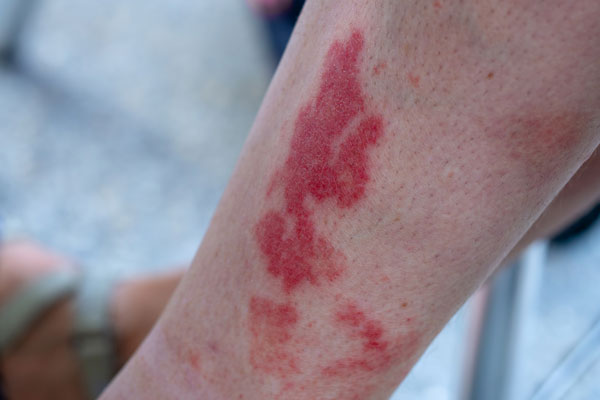
Vasculitis is a term used to describe a group of diseases that cause inflammation of the blood vessels. Vasculitis can affect major arteries and veins, making it a concerning health condition that needs to be correctly managed with medical intervention.
There are various types of vasculitis, and depending on the type you have will vary widely in symptoms, duration and severity. Vasculitis can affect both sexes and all ages, but certain types tend to affect specific groups of people. For example, Kawasaki disease is a vasculitis that occurs only in children, and giant cell arteritis occurs only in adults over 50.
Vasculitis causes poor blood flow, slowing or limiting the delivery of oxygen and nutrients to tissues throughout the body, such as the lungs, skin and nerves. This is why vasculitis can affect people differently; symptoms will vary from person to person. Some signs and symptoms of vasculitis include:
- Numbness or weakness in a hand or foot
- Red spots on the skin, lumps or sores
- Shortness of breath and cough
Vasculitis can affect any area of the body, including organs. So while vasculitis of the kidneys may go unnoticed initially, it is still a serious health problem, and any mild yet persistent symptoms should be investigated.
Vasculitis can be mild or disabling or can even lead to death in severe cases. A patient may only experience one episode of vasculitis, but another could experience many attacks over a few years.
How rare is vasculitis
Vasculitis is a rare and potentially deadly health condition that can cause constriction or occlusion of blood vessels. Early recognition, diagnosis and treatment of this condition can limit its harmful effects and save lives.
Older adults are more prone to giant cell arteritis (GCA), a form of vasculitis also called temporal or cranial arteritis. Although GCA is relatively rare, this vasculitis is one of the most common and almost always affects people over 50. The incidence of GCA increases with age and is particularly prevalent in patients over 65.
What causes vasculitis to flare up?
As with many types of vasculitis, there’s no known cause for its development. However, with GCA, some association with impaired immune response or flares following severe infections are apparent in older adults. Women are also more likely to develop GCA than men, and it is more prevalent in white patients of a northern European background.
It is believed that genetic factors can cause vasculitis to develop. Vasculitis is thought to be an autoimmune disease by medical professionals because it causes the body to come under attack by its own immune system. Some chronic infections, such as hepatitis C or hepatitis B virus, can cause vasculitis.
Vasculitis can also be part of the symptoms of other rheumatic diseases, such as systemic lupus erythematosus, rheumatoid arthritis and Sjögren’s syndrome. However, most patients with vasculitis have none of these health conditions.
Why is vasculitis so painful?
Because vasculitis is a systemic illness, patients will feel sick with various symptoms. They can experience a range of symptoms, including high fevers, weight loss, fatigue, a rapid pulse, and aches and pains that are diffused around the body and difficult to pinpoint.
It is no wonder that vasculitis is described as a hurting disease because it is associated with pain of one type or another. Patients can experience pain from nerve infarction, insufficient blood to the gastrointestinal tract, and painful skin ulcers. Vasculitis can involve virtually every organ and system in the body.
How long does it take for vasculitis to clear up?
Vasculitis can be a short-term or lifelong health condition. Your doctor or medical specialist will focus on getting you better and preventing permanent damage to vital bodily organs, such as the brain, kidneys and lungs, and the nervous system.
There are often accompanying health issues with vasculitis that need treatment, such as fatigue, muscular and joint pain, arthritis, nose and sinus problems, and many other problems. Fortunately, with current medical treatments, the outcome for patients with vasculitis is often good and much improved than in previous decades.
Recovery from vasculitis will depend on your type of vasculitis and its severity. Those with mild symptoms caused by an infection may recover faster than those with more severe, long-term conditions who also have an autoimmune disease.
Can you live a normal life with vasculitis?
Depending on your type of vasculitis and its severity, it will impact your everyday life in some way. Adapting to life with this health condition can be challenging, but it can be more easily managed the more you know about it and ensure you receive the proper treatment.
Most people with vasculitis cope well with life and can adapt their circumstances to make it easier. In most cases, life can be different but not necessarily worse because of the condition.
Types of Vasculitis
There are around 20 different health disorders classified as vasculitis, which cause inflammation within blood vessels or inflammation in arteries. Although the diseases are similar in some ways, they often differ with respect to which organs are affected.
The different types of vasculitis include:
- Behcet’s Disease: Characterised by mouth ulcers, genital ulcers, and eye inflammation.
- Buerger’s Disease: Mainly affects smokers, leading to decreased blood flow to the hands and feet.
- Eosinophilic granulomatosis with polyangiitis (EGPA): Associated with asthma, nasal polyps, sinusitis, and elevated eosinophil counts, which tend to involve the lungs, peripheral nerves, skin, kidneys, and heart.
- Cryoglobulinemia: Characterised by recurrent red dots on the skin of lower extremities.
- Giant Cell Arteritis: The most common type of vasculitis in adults over 50. It is characterised by fever, headache, and jaw and scalp pain.
- Henoch-Schönlein Purpura: Often self-limited and follows after an upper respiratory tract infection.
- Microscopic Polyangiitis: A systemic vasculitis affecting small and medium-sized blood vessels associated with the autoantibody, ANCA.
- Polyarteritis Nodosa: A systemic vasculitis involving many different organ systems focused on medium-sized arteries.
- Polymyalgia Rheumatica: Pain and stiffness local to the shoulders and hips, often associated with Giant Cell Arteritis.
- Rheumatoid Vasculitis: A vasculitis that can complicate the course of rheumatoid arthritis (RA).
- Takayasu’s Arteritis: Affecting the aorta, its major branches to the extremities, and sometimes internal organs. It usually occurs in young women under the age of 50 years.
- Granulomatosis with Polyangiitis: A systemic disease that involves the lungs, kidneys, upper respiratory tract, and other organs and is associated with the autoantibody, ANCA.
Article by Dr. Naveen Bhadauria



